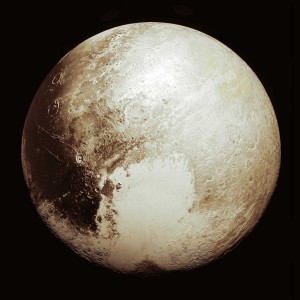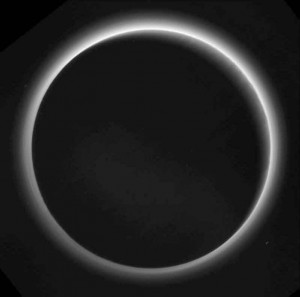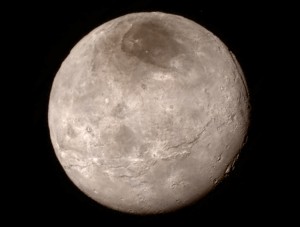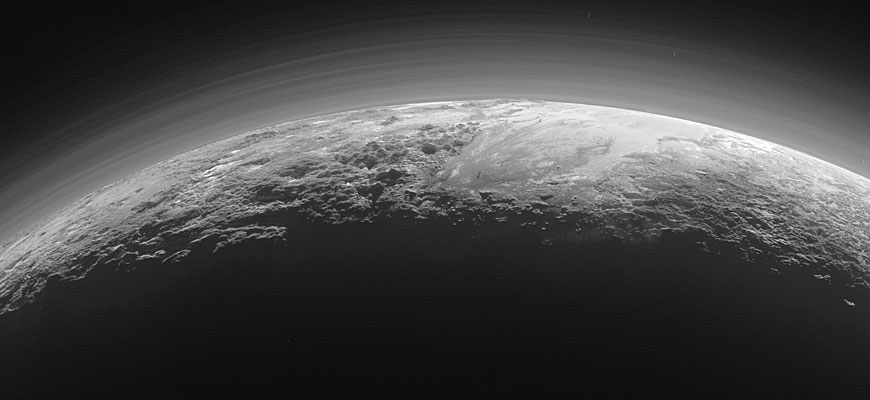In the eternal twilight of the distant sun, pockmarked Charon cast a dim, eerie glow across the icy plains of Tombaugh Regio. The dark, tidally-locked moon held its place in the sky overhead. It was almost as if the orb were watching over the recently–unified team of explorers as they methodically made their way through the rolling hills of ice. Easing the rover to a brief halt, astronaut John Casey squinted at the distant lantern of Sol through the thinly veiled in methane haze on the horizon. Placing a gloved hand in front of his faceplate, he easily blocked out the singular pinpoint of light.
As his eyes adjusted, he surveyed the shadowy Plutonian panorama with a mix of awe and resolve. The surface here in Sputnik Planum differed drastically from the other areas they had explored during their brief days on the dwarf planet. The oozing nitrogen ice floes beneath the rovers treads continued their imperceptible eons-long advance across the planet’s icy crust.
The three billion mile journey from Earth that brought Casey and his fellow explorer, Dr. Tara Embry, through the realm of the Gas Giants had not been without incident. The catastrophic (and spectacular!) failure of the Jansen Drive had left their experimental two-person spacecraft stranded in the dark between the orbits of Saturn and Uranus—the result of a hastily ill-conceived race into the unknown. A very bad place to be.
Were it not for the mutinous sacrifice of the Chinese Taikonauts who now shared this vehicle, Casey would not have made it here. He would in fact, be well on the way to his own death. He flashed a heartfelt smile at mirrored faceplate of Captain Cheng and pointed toward to hatch. While his spacesuit obscured his face, Cheng’s nodding gesture was easy to discern. Both men began to unbuckle their restraints.
As their rugged, well-insulated boots crunched soundlessly on the exotic hydrocarbon surface, Casey pondered Pluto’s four-and-a-half billion year history. Had it’s existence began inward—closer to the sun during the tumultuous birth of the solar system? Eventually cast outward into it’s odd orbit by a massive Jupiter that appeared to have bounced around the infant solar system like an enormous billiard ball. Or had the small world originated here in the cold flotsam and jetsam of the Kuiper Belt—the remnants of the initial solar nebula that gave birth us all? Perhaps the sensors and science packages they had deployed in the all-too brief days here would eke out the answer.
Regardless, it was all good. So good. Together, the newly unified American/Chinese team had utilized humanity’s greatest technological achievement of all-time to leapfrog beyond the enduring goal of Mars to enter the truly unknown depths of space. Who could possibly have believed that in little more than a century after its discovery people would actually be standing on the surface of the classic ninth planet!
Written above is an except from a recent treatment I’ve been developing for my developing science-fiction film project, Arrow of Heaven.
What amazes me is that I could not have written it a month ago. Well, that’s not entirely true… I could have actually made up all of planetary geology aspects. But now, thanks to the amazingly successful New Horizons mission, I can now write a story that is true science fiction story about Pluto because we are beginning to understand the real science of Pluto.

On July 14th, 2015—fifty years to the day after the first successful planetary flyby via NASA’s Mariner Four—I had the privilege of being present as a guest at the Applied Physics Laboratory in Maryland. The New Horizons space probe careened through the Plutonian system at the inconceivable rate of 31,000 miles per hour (750,000 miles a day!).
It has gathered a complex and thorough mass of data that will take sixteen months to fully receive and process. Information from the spacecraft took four-and-a-half hours to reach the mission scientists back on Earth. I was there waited on pins and needles with hundreds of others as the ‘phone home’ signal—indicating the craft was functional—finally arrived over twelve hours after the probe made its successful transit. The sense of adulation, excitement, and pride amongst those in attendance (including scientists, academia, and the press) as each milestone was achieved was explosive and genuine.

The team from NASA/APL, led by the stalwart and brilliant Dr. Alan Stern, deserved every iota of the congratulations and admiration they have received. Here is a mission that was built from the ground up in four years after it was approved and launched nearly a decade ago—yes, it took that long to travel the three billion miles to Pluto! This is a monumental achievement that should go down in the history books as one of the greatest things humans have accomplished.
The people behind New Horizons (a quarter of whom are female, by the way, including the awesome Mission Operations Manager Alice Bowman) aren’t a bunch of geeks and nerds. They are real heroes and explorers. Scientific rockstars. Individuals who used their minds, meticulous engineering, and innovation to finds out a way to extend our senses across the void to witness places that once only existed in imagination. Mythical worlds such as the fabled ‘Planet X.’
What was discovered?
Imagine a world so distant from the sun that it’s 50,000 times dimmer than Mars. That makes it pretty hard to see from our neck of the woods. What was a once a mere speck on photographic plates first viewed by twenty-four year old Clyde Tombaugh at the Lowell Observatory in Flagstaff, Arizona in 1930 has now evolved into a patch of blobby color (as observed by the Hubble Telescope) to what is now a vibrant and geologically-active world.

In the short hours before and after the closest approach of a mere 7800 miles (!), New Horizons performed a sophisticated, comprehensive survey of the planetary system of Pluto and its five moons: Charon, Nix, Hydra, Styx, and Kerberos. It was finally verified that Pluto is actually 1,473 miles (2,370 km) in diameter — a fact that was impossible to determine for distant telescopes.
Special instruments analyzed the spectrum of the light reflected from Pluto’s surface. It discovered exotic compounds on the surface. Ices made of nitrogen and water. An atmosphere of methane that precipitates onto the surface. Reddish areas are comprised of material scientist have dubbed “tholins” — hydrocarbon molecules that form when cosmic rays and solar ultraviolet light interact with Pluto’s atmosphere. These compounds are organic in nature. The building blocks of life. Could the planet harbor something more than exotic frozen terrain? Time will tell. The goal of robotic planetary exploration is to go from a flyby; to an orbiter; to a lander; followed by a rover, to what would ultimately serve as a sample return mission.

What lies ahead?
In the coming months, the New Horizons data will continue to answer fundamental questions. about Pluto and its system. I can’t wait to see the high resolution composites of the planet. The resolution will be measured in not miles, but yards! Imagine the detail. The team has identified at least two more Kuiper Belt Objects that could serve as targets for the probe. Both bodies — named 2014 MU69 and 2014 PN70 — lie about 1 billion miles (1.6 billion km) beyond Pluto. A second flyby would likely occur in early 2019. I have my fingers crossed for that. They are much smaller and very different in composition, but interesting nonetheless.
How long will it last?
The mission of NASA is to Innovate, explore, discover, and inspire. I would say New Horizons accomplished all four objectives in spades. the spacecraft has a Radio Isotope Thermal Electric Generator on board that utilizes, you guessed it, Plutonium as a power source. It should provide power until the 2030 when New Horizons will be over 100 times the distance from the Earth to the sun (also know as an A.U. or Astronomical Unit). This should allow for a detailed analysis of the heliosphere and other aspects of the boundary between our solar system and interstellar space. All along the way, the ashes of Clyde Tombaugh will be along for the ride. A fitting legacy to his amazing discovery in the 20th century.

As for my project, Arrow of Heaven, I hope to direct it as my third film after Oceanus and Venus are completed. It is a major passion project for me that I literally started conceiving while I was in Maryland at APL. Since then, it has become a bit of an obsession and a project that I hope will literally allow me to work in partnership with both NASA and the China National Space Agency. Additionally, I want it to revolutionize the interstellar space opera. The seed of a franchise that could rival the original Star Trek. Time will tell. And by then—most likely the early 2020s—who knows what more we will know about Pluto.
No matter what, New Horizons will have given us the answers. I can’t wait to see what’s in store!

Pluto fly-by animation
